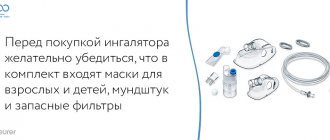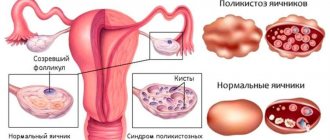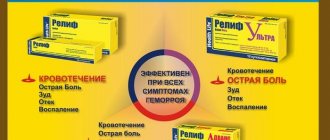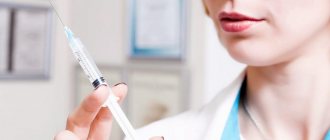- Differences between an inhaler and a nebulizer
- What does a nebulizer consist of?
- What does the size of aerosol particles indicate?
- For what diseases are inhalers and nebulizers used?
- Tips for choosing an inhaler
- At what age can you use an inhaler?
- How to choose an inhaler for children
- What is important to remember
An inhaler is a device for inhaling medications for the prevention and treatment of respiratory diseases. In this article we will tell you how to choose an inhaler, how these devices differ, what types they exist and who they are suitable for.
Differences between an inhaler and a nebulizer
There are four types of inhalers. The simplest ones are steam. They turn the medicine into inhalable vapor. The other three are more complex systems called “nebulizers.” They turn medications not into vapor, but into a fine aerosol. Depending on the technology, there are compressor, ultrasonic and mesh nebulizers. Despite this difference, the words “inhaler” and “nebulizer” are often used interchangeably.
Steam inhaler
The steam inhaler heats and vaporizes the medicine. The resulting steam consists of large particles. They cannot penetrate the lower respiratory tract, so steam inhalers are only suitable for treating the upper respiratory organs - the nasal cavity, nasal and oral parts of the pharynx.
Steam inhalers are cheaper and have their disadvantages.
- The concentration of the sprayed substance is often below the minimum required for therapeutic effect.
- There are only so many medications you can use with a steam inhaler: most medications are destroyed by heat. Therefore, essential oils, saline solutions or mineral water are suitable for the inhaler.
- Steam inhalations are contraindicated at high body temperatures.
- Inhalations using steam devices give results only at the onset of the disease or are used for prevention.
Types of nebulizers
Compressor nebulizer
A compressor nebulizer creates an aerosol using air that enters the chamber with the medicine under pressure. This inhaler works best for coughs and runny noses. However, inhalations can only be done at home - such devices operate on mains power and take up a lot of space. Any medication can be used with a compressor nebulizer.
Ultrasonic nebulizers
Ultrasonic nebulizers create an aerosol by vibrating a piezoelectric element on the surface of the solution. They are compact and silent, so they are convenient to take with you. The noiselessness allows small children to inhale even when they are sleeping. The disadvantage of this technology is that the device cannot use antibiotics, hormones, mucolytics and other substances that are destroyed when heated. You can inhale saline solution, mineral water, and medicines based on plant extracts.
Mesh inhalers
Mesh inhalers create an aerosol by sifting the medicine through a fine mesh membrane (mesh in English - “mesh”). Such nebulizers are well suited for allergy sufferers and asthmatics. You can use any medicine with them and carry out inhalations anywhere - they are compact and run on batteries. Tilt does not affect the operation of the mesh inhaler, so it can be used to perform procedures while lying down. Typically, devices of this type are more expensive than others.
The best ultrasonic nebulizers
An ultrasonic nebulizer creates an aerosol using high-frequency vibrations. Ultrasonic nebulizers have high reliability and performance. They are characterized by silent operation and small size.
Ultrasonic compact nebulizer B.Well WN-119 U
A silent and compact device for inhalation!
The ultrasonic nebulizer is intended for inhalation treatment of asthma, various forms of allergies and other respiratory diseases.
This nebulizer has two spray speeds, which allow you to choose a convenient inhalation mode, which is especially important for children or bedridden weakened patients.
Ultrasonic compact nebulizer B.Well WN-116 U
Ultrasonic travel nebulizer Bee Well WN-116U with a unique “Closed water tank” system.
Lightweight, compact, reliable device. It provides effective therapy: average aerodynamic particle size of 3.8 microns, air flow rate of 0.5 ml/min, continuous therapy up to 30 minutes.
Ultrasonic inhaler Monsoon-2-03
Advantages of the nebulizer Monsoon 2-03:
- a wide range of sprayed medicines, essential oils, herbal infusions;
- absolutely silent operation makes it possible to perform the procedure on seriously ill patients during sleep;
- heating the aerosol increases the comfort of the procedure;
- adjusting the spray intensity makes it possible to set the most suitable mode;
- stable body;
- thanks to the medicine cup, medications do not come into direct contact with the piezoelectric element;
- Suitable for adults and children from the first days of life.
Mesh inhaler B.Well
Mesh or electronic mesh nebulizer B.Well WN-114 is one of the most technologically advanced nebulizers presented on the Russian market.
Firstly, it is based on the latest mesh spray technology, which allows the use of an expanded list of drugs for inhalation. Secondly, this device allows for inhalation with maximum comfort.
Mesh spraying technology is the “sifting” of drug particles through a mesh membrane. Ultrasonic vibrations of low frequencies are applied not to the drug, but to the membrane mesh, so the molecules of the inhaled substance are not destroyed. The nebulizer allows you to use an expanded range of drugs: antibiotics, mucolytics, hormonal drugs, including Pulmicort and Fluimucil. Mesh technology ensures completely silent operation, high dispersion and spraying speed.
What does the size of aerosol particles indicate?
The effectiveness of a nebulizer in treating a particular disease depends on the average size of aerosol particles.
Particle size is usually measured in micrometers (µm). Nebulizers produce an aerosol with particles of various sizes.
- Particles with a diameter of 5–10 microns
settle in the larynx and nasopharynx. - 2–5 microns
- in the trachea and bronchi. - 0.5–2 microns
- penetrate the alveoli.
However, the technical characteristics of the device indicate the average particle size.
So, if a nebulizer has an average particle size of 3 microns, this means that only half of all aerosol particles will be 3 microns, the other half will consist of particles of larger and smaller sizes. Some of them will settle in the larynx, some in the alveoli. Thus, nebulizers with an average particle size of 2 to 5 microns affect all parts of the respiratory system. They are well suited for treating seasonal diseases. For many models, it is possible to switch the particle size for targeted therapy of a particular area of the respiratory system.
Optimal approaches to cough therapy. Chapter 8
Currently, the optimal treatment strategy for chronic cough is a combined approach. It consists of the following steps:
- identification and control of factors causing cough syndrome (eosinophilic inflammation, gastroesophageal reflux, postnasal drip, psychogenic disorders, etc.);
- use of antitussive drugs;
- non-drug therapy.
It is clear that treatment of persistent, debilitating chronic cough is impossible without identifying its cause. A pedantic assessment of cough syndrome, a thorough history taking, a traditional objective examination of the patient and skillful auscultation of the lungs are required. A chest x-ray is required. The doctor must decide for himself whether additional studies, such as bronchoscopy and 24-hour pH-metry, and consultations with an otolaryngologist and other specialists are required. Establishing the possible cause of cough syndrome allows for targeted etiological therapy. If the diagnosis is not established, they speak of an idiopathic “unexplained cough” and carry out empirical treatment.
It should be emphasized that antibiotics, bronchodilators, and expectorants are not antitussives. Antibiotics are used in cases where the cough is caused by a bacterial infection characterized by purulent sputum (purulent bronchitis and sinusitis, bronchiectasis, exacerbation of COPD). B2-adrenergic drugs may improve mucociliary clearance but do not improve cough.
| Table 1. Medicines with proven or possible antitussive effect *Not all substances are available in all countries |
| Fig.1. Pathways of the cough reflex and points of therapeutic intervention. |
Medicines that have a direct antitussive effect (“antitussive”) are divided into drugs of central (narcotic and non-narcotic) and peripheral action, which are used to treat acute, subacute and chronic cough (see Table 1). Narcotic antitussive drugs of central action include morphine-like compounds (opium alkaloids of the phenanthrene series): codeine and compounds close to morphine (hydrocodone phosphate, etc.). A popular non-narcotic antitussive drug is dextromethorphan hydrobromide, which acts directly on the cough center, reducing its sensitivity threshold. The effectiveness of the drug has been proven by studying objective parameters using acoustic monitors in patients with acute cough. Prenoxdiazine and levodopropizine are peripherally acting antitussives. They suppress the release of neuropeptides (substance P, etc.), histamine, have a local anesthetic effect on the mucous membrane of the respiratory tract, and have bronchodilator and anti-inflammatory properties.
Rengalin is a complex drug that affects various pathogenetic components of the cough reflex, modifying the activity of ligand-receptor interaction of regulators with the corresponding receptors. Release-active (RA) antibodies to bradykinin bind to bradykinin receptors, RA antibodies to histamine - to histamine receptors, RA antibodies to morphine - to opiate receptors. The presence of these components in Rengalin is due to the pathophysiological role of bradykinin, histamine and opiate receptors in the development of cough.
The influence of Rengalin on these receptors makes it possible to selectively reduce the excitability of the cough center of the medulla oblongata, lower the threshold of excitation of irritant receptors of the respiratory tract, and also influence the peripheral part of the cough reflex arc.
It is worth noting that in the presence of codeine-like action, Rengalin does not have the risk of developing side effects characteristic of centrally acting antitussive drugs. Rengalin has a combined effect due to the presence of components active against acute and chronic (dry/productive) cough. The therapeutic effect of Rengalin is manifested in the effective relief of daytime and nighttime cough. Rengalin has an antitussive effect, helps relieve cough and infectious inflammation in the respiratory tract without the development of secondary bacterial complications. Rengalin is an effective treatment for patients with cough due to ARVI, acute pharyngitis, laryngitis, laryngotracheitis, tracheitis, and bronchitis. Patients have a high level of adherence to therapy.
First generation antihistamines (H1 receptor blockers) (diphenhydramine, pipolfen, suprastin) are approved in a number of countries as antitussives. Drugs in this group are able to penetrate the blood-brain barrier and influence central H1-histamine receptors, causing a sedative effect and a decrease in the excitability of the cough center. It is advisable to use these drugs to suppress cough, which is based on an allergic component, such as, for example, in patients with allergic rhinitis, asthma, postnasal drip syndrome. However, antihistamines cannot be used as empirical therapy in cases of chronic or nonspecific cough, especially in children. Antihistamines of new generations do not have antitussive properties.
Inhaled anticholinergics are not included in the traditional classification of antitussives, but they are known to have a suppressive effect on cough. For this, two potential mechanisms have been proposed: blocking the afferent part of the cough reflex and reducing the stimulation of cough receptors by influencing mucociliary factors. It is reported that inhalation of ipratropium bromide (2 doses of aerosol - 40 mcg 4 times a day) significantly reduces daytime and nighttime cough in patients with post-infectious cough. For some patients, the cough may stop completely.
Opinions regarding the effectiveness of mucoactive (expectorant) drugs for the treatment of cough are quite controversial. These drugs do not have antitussive properties. Proponents of their use justify the therapeutic effect by reducing the viscosity of sputum and facilitating expectoration. The symptomatic use of expectorants is recommended in patients with COPD and bronchiectasis to improve the rheological properties of sputum and facilitate its elimination. In some patients with COPD and chronic productive cough, mucolytics may reduce the frequency of exacerbations. Mucolytic therapy should be discontinued if no effect is observed after four weeks of treatment. Some patients, using self-medication, report the subjective effectiveness of expectorants for acute bronchitis. Demulsents (lat. Demulcere) are products that form a film over the mucous membranes. It is believed that some demulsants exhibit antitussive properties by “coating” cough receptors and reducing their irritation. Demulsants—pectin, glycerin, honey, and molasses—are the main ingredients in various over-the-counter cough syrups and lozenges.
Inhaled local anesthetics, primarily lidocaine, are good for treating difficult-to-control cough in adults. They are increasingly used to treat persistent, painful cough in patients with lung cancer as part of palliative care. Along with reducing cough, inhaled lidocaine reduces the perception of shortness of breath in patients with end-stage lung cancer. In rare cases, lidocaine inhalations are used when traditional antitussives are ineffective for chronic cough. Positive properties are associated with blockade of afferent receptors of the respiratory tract. Sprayed through a nebulizer, a 5% lidocaine solution is used at a dose of 10-40 mg per inhalation 3 to 4 times a day. There are recommendations for a possible increase in the dose to 120 mg of lidocaine. The number of procedures is determined by the effectiveness of therapy.
Non-drug methods for treating cough are also very popular. The methods of “traditional medicine” consist primarily of distraction therapy techniques: warming up, rubbing the chest, cupping, mustard plasters, hot hand and foot baths, warming compresses, and other physiotherapeutic procedures. “Steam inhalations” were widely used, which, however, could only worsen the cough. Alternative methods include acupuncture, aromatherapy, and herbal medicine.
Well-tested methods of suppressive therapy for chronic, refractory cough include behavioral therapy programs (“Speech and language therapy”), which include education and psychological consultations, laryngeal hygiene and hydration, antitussive techniques, and breathing exercises. Such methods were first proposed in the late 80s of the last century for the treatment of patients with psychogenic cough.
The outpatient stage of therapy consists of 2-4 sessions. Such therapy for patients with persistent cough is a promising method, and can be used as part of self-help management programs and minimize the undesirable consequences of excessive, intense cough. After treatment, there was a significant decrease in cough frequency and improved sleep. A number of studies have shown that the sensitivity of the cough reflex is reduced.
Protussive therapy, that is, the mobilization and removal of sputum from the bronchial lumen, is an important component of optimizing pulmonary clearance. It should be carried out in patients with chronic respiratory diseases, the main symptoms of which are cough and sputum production. Such diseases include COPD, bronchiectasis, and cystic fibrosis. When treating them, a differentiated approach is important using various mucoactive drugs, physical and kinesitherapy methods. The main goal of treatment is to facilitate the removal of mucus from the lumen of the bronchial tree, which helps relieve cough and improve the subjective condition of patients.
There are a variety of non-drug methods to improve pulmonary clearance. In the past, such concepts as “morning bronchial toilet” and “bronchial hygiene” were quite well known. The most well-known methods of improving sputum evacuation include postural (positional) drainage, manual percussion and vibration. In recent years, active cycle breathing techniques (ACBT) have been introduced into pulmonology practice: forced expiratory breathing, “huffing”, controlled coughing, relaxation and breathing control.
The line of original mechanical devices with various properties that facilitate the evacuation of sputum is constantly expanding. Devices are available that create oscillatory vibrations during exhalation - flutter (English: flutter, tremble). The vibration effect helps separate mucus from the walls of the bronchi, which helps remove phlegm. Innovative technologies include equipment for intrapulmonary percussion ventilation and devices for extrathoracic mechanical percussion.
For what diseases are inhalers and nebulizers used?
Inhalers are designed to combat various diseases of the respiratory system, but they can also be used for prevention. As a rule, procedures are prescribed to alleviate a dry cough during a cold. A nebulizer helps relieve swelling and moisten the airways. Cough with phlegm can also be treated with an inhaler, which helps remove phlegm from the lungs.
The nebulizer is also used to strengthen the immune system and for the following acute and chronic diseases.
- Runny nose.
- Acute or chronic rhinitis.
- Mild forms of bronchitis.
- Mild form of pneumonia.
- Fungal and viral infections.
- Inflammation of the mucous membranes.
The inhaler is also used for complex diseases with acute attacks - asthma and allergic reactions - for quick relief. In such cases, the doctor selects medications.
How to perform inhalations
- Inhalation is carried out no earlier than 1-1.5 hours after a meal or after physical activity.
- Smoking before and after inhalation is prohibited.
- It is advisable to gargle with plain water before inhalation.
- For diseases of the nose and nasopharynx, inhalation and exhalation are done through the nose using nasal cannulas.
- For diseases of the lower respiratory tract (bronchi, trachea), you need to use a special mouthpiece. During the procedure, you need to take a deep breath, hold your breath for a couple of seconds, and then exhale through your nose.
Tips for choosing an inhaler
If you are taking medications with a strict dosage (such as hormones), choose a nebulizer that synchronizes with your breathing.
Such models deliver an aerosol only during inhalation, which allows you to save medicine and accurately adhere to the dosage. Here are the suitable models.
Inhaler OMRON Comp Air NE-C24
Inhaler OMRON CompAir NE-C28 Plus (NE-C28P-RU)
Inhaler Little Doctor LD-212C (white)
Inhaler Little Doctor LD-210C
Compressor inhalers are suitable for those who are looking for a cough remedy, as well as for patients with chronic diseases who need frequent inhalations. Powerful nebulizers with a high inhalation rate are good for these purposes.
For seriously ill patients who need lengthy procedures, models with a large chamber volume and a powerful compressor that operate continuously are suitable. For example, B.Well PRO-110, A&D CN-233, OMRON CompAir NE-C28 Plus, A&D CN-231.
Small children may be frightened by a loud device, so if the inhaler is for a child, pay attention to the noise level. As mentioned above, the quietest nebulizers are ultrasonic. Mesh inhalers are also quiet. Many compressor inhalers for children come in the form of toys or with various fun designs to interest the baby.
Inhaler OMRON Comp AIR NE-C24 Kids
Inhaler B.Well PRO-115 Locomotive
Inhaler A&D CN-232
Inhaler Little Doctor LD-212C (yellow)
If you need to always have your inhaler at hand, choose a nebulizer with mesh technology. Ultrasonic nebulizers are also portable, but remember that not all medications can be used with them. For example, Little Doctor LD-207U, A&D UN-233 are suitable for you.
When choosing an inhaler, pay attention to the residual volume of medication in the chamber. The smaller it is, the more economically the product will be spent. This is important when it comes to expensive medications.
For the treatment of diseases of the upper respiratory tract, a steam inhaler or any nebulizer that sprays an aerosol with large particles, 5–10 microns in size, is suitable. As a universal device, you can choose a nebulizer with the ability to adjust the particle size.
Use of inhalations
- For the prevention of respiratory diseases and moisturizing the mucous membrane of the respiratory tract.
- Treatment of bronchial asthma, chronic bronchitis, cystic fibrosis, COPD.
- In the complex treatment of rhinitis, sinusitis, pharyngitis, tracheitis, bronchitis.
- For children and the elderly.
- For patients with severe illnesses.
Causes and treatment of cough
Benefits of inhalation
- Direct delivery of the drug to the area of inflammation.
- Pure substance without impurities.
- Possibility to introduce any amount of dosed substance.
- Fast, instant action of the drug.
- Fewer side effects, since the drug does not enter the blood.
- Permitted for use in infancy, in postoperative conditions, and in coma.
- Maximum efficiency at the lowest cost.
Contraindications
Inhalations are not recommended for:
- elevated body temperature;
- cardiovascular failure;
- nosebleeds;
- emphysema;
- oncological diseases.
At what age can you use an inhaler?
Before using the device, you should know at what age the inhaler can be used.
The nebulizer can be used by children from a very early age. Pediatricians advise using such devices even when treating infants. For young children, purchase an inhaler with convenient attachments (mouthpiece, nose tip, small face mask). Some brands sell a children's mask separately.
How to choose an inhaler for children
- To choose an inhaler for a child, carefully read the instructions before purchasing. The main parameter is safe operation. Therefore, children under one year old should not use steam devices: it is difficult for babies to cough up mucus.
- For a small child, it is better to choose an ultrasonic or mesh inhaler, as these devices are silent and have temperature control.
- An element of entertainment that distracts from the procedure is also important. Therefore, many manufacturers offer nebulizers in the form of toys with bright and colorful designs.
- Treatment of children should be carried out under the strict supervision of adults. In this case, the procedure should not last longer than 5 minutes.
The best steam nebulizers for inhalation
The steam inhaler is able to constantly maintain the steam temperature at 43C°, thereby achieving the maximum therapeutic effect.
It is at this temperature that many harmful viruses and bacteria die, and histamine, associated with the occurrence of allergic reactions, is neutralized. At the same time, steam at this temperature is inhaled easily and comfortably, without burning or irritating the mucous membranes.
Some of the best steam nebulizers for inhalation today are produced by B.Well.
Steam inhaler B.Well
The Miracle Steam inhaler can be used by people of any age.
The device is equipped with a function for selecting particle size depending on the type of inhalation. When inhaling steam through the nose, smaller particle sizes are more comfortable and effective; when inhaling through the mouth, larger particle sizes are suitable.
Aesculapius medical equipment salons offer to buy a nebulizer for inhalation in Rostov-on-Don, Azov, Bataysk. The best ultrasonic, compressor, steam nebulizers, and inhalers are available for sale.
Share on social media networks:
What is important to remember
- If you need a device only for adults in case of treating a cold without fever, take a simple steam inhaler.
- If you need an inhaler for children that will help with coughs and runny noses, or you need a universal family model, choose a compressor device. It will work with all types of medications.
- Those suffering from asthma, allergy sufferers, or those who prefer to always have an inhaler at hand should choose mesh nebulizers. They are compact and work with any medicine.
- For inhalations, it is better for children and infants to choose between mesh inhalers and ultrasonic ones. They are quieter than compressor ones and deliver an aerosol in any position: you can inhale even while the child is sleeping. However, remember that ultrasonic devices cannot nebulize all types of medications.
Additional selection criteria
Portable ultrasonic nebulizer
The purchase of a specific model should be based on the ultimate goal and features of the future treatment. For example, it makes sense to purchase an ultrasound model if therapy will be carried out with medications and other components of natural origin.
When using other drugs, you can safely focus on a compressor or electronic inhaler. In general, when choosing the most suitable, optimal option, you need to focus on:
- method of aerosol supply - continuous will lead to inappropriate use of the drug;
- the presence of batteries or an accumulator if the inhaler is needed while traveling or moving;
- noise level - everyone prefers silent models;
- ease of maintenance and maximum simplicity in use.
It is important to consider the time of continuous operation. Many nebulizers require a break, which makes it impossible to use them several times in a row for two or three or more people. If the family has small children or people prone to colds, it is advisable to purchase a powerful inhaler.
Typically the duration of work ranges from 20 minutes to one and a half to two hours. Compressor nebulizers can operate without interruption.
Membrane and compressor models of nebulizers best suit the presented requirements. The first ones are the most expensive, but they are the most economical and durable.











